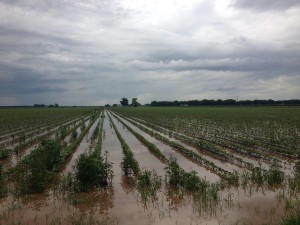Gaylon Morgan, Professor and Extension Cotton Specialist
Much of the South Texas, and possibly some of West Texas’ cotton acres, will be down due to the excessively wet weather both prior to planting and following planting. Planting the seed and stand establishment were initially the concerns in South and East Texas. Now the concern is how long can cotton handle saturated soils and cloudy conditions. Below is some information and considerations when trying to make management decisions on cotton during this wet spring and summer.
In waterlogged soils, water replaces air in the soil and plant roots become deprived of oxygen. Clay soils can become depleted of oxygen after just 2 days of standing water, especially where high nitrogen levels are present in the soil. As roots become deprived of oxygen, plants are unable to maintain normal respiration, which provides energy and the building blocks for shoot and root growth. As seen this season, cotton can handle saturated soils for quite some time; however, plant growth will remain slow and each developmental stage will be delayed. Previous research has shown that under short-term flooding (7 days) leaf growth is decreased by over 25% and photosynthesis by over 15%, while root growth was not hindered little. However, under continued saturated conditions, I suspect root growth will also be significantly impacted and may have a long-term detrimental impacts on total root growth, root distribution, and yield potential.
Typically, cotton roots grow 0.5-2 inches per day and plants will have a root system extending 3+ feet deep by the first flower growth stage. The vast majority of root growth occurs the first 60 days after germination. In waterlogged soils, root growth will be slowed, and roots will tend to proliferate near the soil surface where more oxygen is present. Reduced growth and shallow depth of the roots make plants more susceptible to drought stress later in the season. Additionally, producers should be careful when cultivating to minimize root pruning, which can further hinder the crop growth. Because of these impacts on root growth and function, saturated soils also inhibit nutrient uptake, specifically phosphorous and potassium, along with nitrogen and other nutrients. An obvious response for some producers may be to apply foliar nutrients to remediate observed or anticipated nutrient deficiencies. Foliar applications of nutrients may result in a slight improvement in appearance, but are not likely to result in an economical yield increase. Soil nitrates (plant available form of nitrogen) also can be lost from the soil as a gas once anaerobic conditions occur. As a result, supplemental N may be needed in some cases to meet plant needs for the season. See the publication from Mississippi State University titled “How to Estimate Nitrogen Loss resulting from Saturated Soils”. However, in most cases once waterlogged conditions subside and sunshine returns, normal plant growth and nutrient uptake will resume, and nutrient deficiency symptoms typically will go away. Regardless, plants cannot compensate for this lost time and crop harvest will be delayed as a result.
After the soil begins to dry out, there will likely be the urge to apply plant growth regulators (PGRs) to control plant size and possibly promote earlier maturation. However, we must keep in mind that waterlogged conditions also inhibit plant hormones, which contribute to growth and leaf expansion. So, be cautious about applying PGRs too soon after waterlogged conditions, because applications too early could further decrease the yield potential, especially for some varieties. Please consult with the seed company about the recommended PGR regime for each variety.
The 2015 season has been a challenge. The flooding and waterlogged soils will definitely delay crop development; however, once established, cotton is a tough plant that can compensate for many adversities. So, do not give up on our 2015 cotton crop too early.

Young cotton plants struggle to survive waterlogged conditions caused by excessive spring rains in the Brazos Bottom.

Dr. Gaylon Morgan Professor and Extension Agronomist, College Station, TX 979-845-2425 gmorgan@ag.tamu.edu